Buster Crabbe, better remembered for his Flash Gordon serials, was once additionally well known to Saturday matinee filmgoers as a B western cowboy hero. In the "Billy Carson" series he made twenty-three films, all co-starring Al "Fuzzy Jones" St. John who often got top billing as an even better known cowboy regular, a specialist at being a crusty sidekick who often steals the whole film by his comic antics.
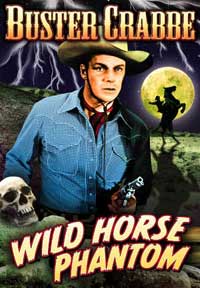 Originally this had been the "Billy the Kid" series. Buster & Fuzzy appeared together in thirteen Billy the Kid episodes beginning with Billy the Kid Wanted (1941) & concluding with Blazing Frontier (1943). The character was revamped & renamed beginning with Devil Riders (1943), apparently because of vendor complaints about pitching outlaw Billy the Kid to children's audiences as a heroic guy. Originally this had been the "Billy the Kid" series. Buster & Fuzzy appeared together in thirteen Billy the Kid episodes beginning with Billy the Kid Wanted (1941) & concluding with Blazing Frontier (1943). The character was revamped & renamed beginning with Devil Riders (1943), apparently because of vendor complaints about pitching outlaw Billy the Kid to children's audiences as a heroic guy.
The Billy the Kid series had predated Buster Crabbe in the starring role, originating with Fuzzy Jones opposite Bob Steele as Billy in six episodes beginning with Billy the Kid Outlawed (1940) & concluding with Billy the Kid in Santa Fe (1941).
The Billy Carson series is of course separate despite so many similarities, as Billy the Kid was an outlaw doing good deeds whereas Billy Carson never was an outlaw. The director of all these films was Sam Newfield who pumped them out weekly until there were dozens & dozens of B westerns, approximately one hour each, under his directorship.
Newfield also occasionally directed B horror such as The Mad Monster (1942) & The Monster Maker (1944). Now & then he at least pretended to to combine genres with mystery-horror-cowboy combinations, though unfortunately the horror ingredient was generally on the order of "a fake ghost" & very disappointing for horror ingredient. Titles like His Brother's Ghost (1945) & Wild Horse Phantom (1944) promised supernatural elements that just weren't realized.
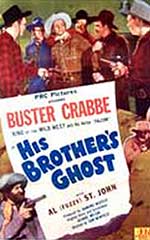 "Bandits terrorize border town!" shout the headlines of a western newspaper. Highlights of His Brother's Ghost include Billy Carson's daring escape from killers, on horseback, with his arms tied; a couple of standard shoot-outs without anyone getting wounded; & some back-&-forth fisticuff action. Pretty regular stuff really, but the novel ingredient is Al St. John playing two roles, first being Andy Jones, second being his own twin brother Fuzzy Q. Jones. "Bandits terrorize border town!" shout the headlines of a western newspaper. Highlights of His Brother's Ghost include Billy Carson's daring escape from killers, on horseback, with his arms tied; a couple of standard shoot-outs without anyone getting wounded; & some back-&-forth fisticuff action. Pretty regular stuff really, but the novel ingredient is Al St. John playing two roles, first being Andy Jones, second being his own twin brother Fuzzy Q. Jones.
Fuzzy visits Andy on his deathbed after the bad guys have shot him. It's one of the simpler old-time special FX sequences with St. John sitting beside himself. The bad guys were pretty sure they'd killed Andy, & someone even saw Andy's night-time burial. But Fuzzy poses as his brother Andy's ghost to unnerve the bad guys.
The bad guys are killing in order to take over land. Head bad-guy has the pointed name Thorn, played by Charles King, the usual foil for Billy & Fuzzy. Most episodes have a female lead, but she rarely has much to do, so this episode leaves her out entirely.
Billy Carson sets out to protect the land owners from these criminals. Billy's the only character with a white horse (Falcon was never as famous as Trigger or Silver but pretty famous), though all the good guys have white hats so there won't be any confusion about who is who.
The story ranges from cute to awful, but would've been a good kiddy program in its day, thanks mostly to Fuzzy.
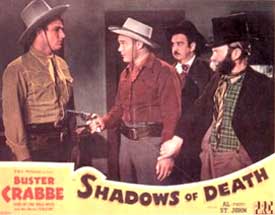 Lately on dvd as a double bill, His Brother's Ghost includes Shadows of Death (1945) on the same disc. Lately on dvd as a double bill, His Brother's Ghost includes Shadows of Death (1945) on the same disc.
Once again our white-hat good-guy Billy Carson is on the scene, hired to help buy up land for the railroad right of way, & assisted by Fuzzy Jones who is better at dickering.
When the black cowboy hats find out about the railroad's precise path, they want to cash in by getting control of some of that land beforehand, & inflating the values. As usual Charles King is kingpin of the bad guys.
There's lots & lots of padding in this episode of Fuzzy doing comedy shtick as a barber, a sheriff, & a judge, since he's a man of all trades in the little town of Redrock, which the train will eventually pass through. Given that Fuzzy is the best thing about the series, his comedy bits are frequently more interesting than the main story.
Miss Babs (Dona Dax) provides the romantic interest, looking sweet in a cowgirl outfit. Buster makes a genial cowboy but for films this cheap, other stars, who could also sing, are more adorable.
The story climaxes with some shooting, some fisticuffs, & surprise of surprises, defeat of the bad guy. 'Tain't nothin' much, but it'll pass less than an hour harmlessly.
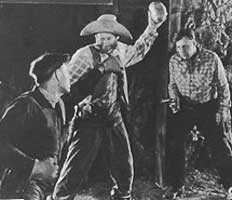 Al "Fuzzy Jones" St. John & Buster Crabbe star in another lame-ass phony-ghost western, Wild Horse Phantom (1944). Al "Fuzzy Jones" St. John & Buster Crabbe star in another lame-ass phony-ghost western, Wild Horse Phantom (1944).
Films like this make the four-film dvd collection Creepy Cowboys a rip-off for horror fans because the packaging captures the horror crowd by putting a spooky scary skull on the box, but do not deliver more than a standard B western.
But if you go into it expecting goofy comedy, fistfights, hard ridin', poorly aimed shootin' between white hats & black hats, & a simpleminded mystery involving a land-grab scheme, Wild Horse Phantom is good of kind.
Buster is once again Billy Carson with his white horse Falcon, this time trying to get a land owner's money back from robbers before ranchers are foreclosed upon & lose their property.
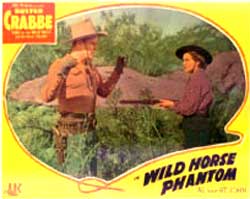 There's been a prison break with a gangster-film look, but soonafter the world turns into a wild west setting. The break was orchestrated so that the bad guys might be followed back to the place where they previously hid their loot, in a rumored-to-be-haunted cave. There's been a prison break with a gangster-film look, but soonafter the world turns into a wild west setting. The break was orchestrated so that the bad guys might be followed back to the place where they previously hid their loot, in a rumored-to-be-haunted cave.
Fuzzy Jones once again plays a duel role, comic relief sidekick to Billy Carson, plus a more serious character.
This western series was much more the Fuzzy Jones Show than it was the Buster Crabbe Show, Fuzzy being the bigger draw to the theaters, & he is always given plenty of time to clown around.
In many episodes he even gets first billing in the opening credits. But Fuzzy's only occasionally permitted a slightly dramatic performance, & this episode shows his range, such as it is.
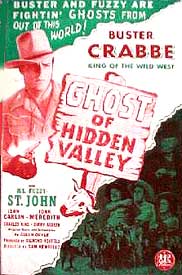 Cave scenes are supposed to be spooky but the comedy entirely squashes any degree of suspense. Cave scenes are supposed to be spooky but the comedy entirely squashes any degree of suspense.
Fuzzy tangles with a giant bat in the not-really-haunted mine. The most famous thing about this episode is the bat is the same dumb prop already seen dangling unconvincingly in The Devil Bat (1940).
The loot that was hidden in the cave is missing, but not to worry, it'll turn up, as there's no such thing as a tragic ending in these things.
The fake ghost routine is revisited in Ghost of Hidden Valley (1946). A young couple trying to become ranchers (Jean Carlin & John Meredith) are being harassed by the gang in the black hats.
They are using the couple's land to hide stolen cattle (so we are told; we never see the stolen herd as a cow wrangler wasn't in the budget for such a quickie cheapie).
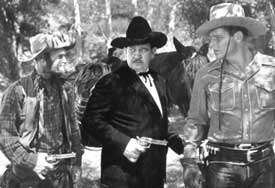 Head of the black-hat gang is as usual Charles King, who played a different villain in each film but often, as this time, was named for his character's heart & hat, Blackie. That's his portly self standing between Fuzzy & Billy in the b/w film still at right. Head of the black-hat gang is as usual Charles King, who played a different villain in each film but often, as this time, was named for his character's heart & hat, Blackie. That's his portly self standing between Fuzzy & Billy in the b/w film still at right.
Jean Carlin puts in a leading lady appearance in cowgirl hat & rifle. And as always Fuzzy Jones with his square beard & toothless jowls is the very epitome of the comic sidekick.
The so-called "ghost" is the ranch's baseless reputation which the outlaws count on to keep people from finding the cattle. Buster Crabbe as the crime-stopping Billy Carson will not be swayed by pretend spooks.
Other of the many Sam Newfield pseudo-weird westerns from other series include Ghost Mine (1941) & Ghost Patrol (1936).
copyright © by Paghat the Ratgirl
|
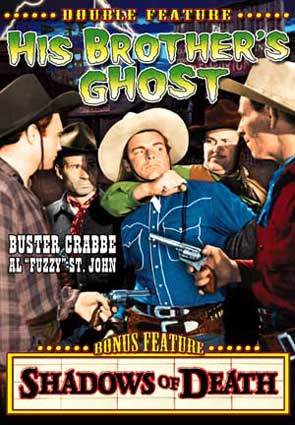
 Originally this had been the "Billy the Kid" series. Buster & Fuzzy appeared together in thirteen Billy the Kid episodes beginning with Billy the Kid Wanted (1941) & concluding with Blazing Frontier (1943). The character was revamped & renamed beginning with Devil Riders (1943), apparently because of vendor complaints about pitching outlaw Billy the Kid to children's audiences as a heroic guy.
Originally this had been the "Billy the Kid" series. Buster & Fuzzy appeared together in thirteen Billy the Kid episodes beginning with Billy the Kid Wanted (1941) & concluding with Blazing Frontier (1943). The character was revamped & renamed beginning with Devil Riders (1943), apparently because of vendor complaints about pitching outlaw Billy the Kid to children's audiences as a heroic guy.


 There's been a prison break with a gangster-film look, but soonafter the world turns into a wild west setting. The break was orchestrated so that the bad guys might be followed back to the place where they previously hid their loot, in a rumored-to-be-haunted cave.
There's been a prison break with a gangster-film look, but soonafter the world turns into a wild west setting. The break was orchestrated so that the bad guys might be followed back to the place where they previously hid their loot, in a rumored-to-be-haunted cave. Cave scenes are supposed to be spooky but the comedy entirely squashes any degree of suspense.
Cave scenes are supposed to be spooky but the comedy entirely squashes any degree of suspense. Head of the black-hat gang is as usual Charles King, who played a different villain in each film but often, as this time, was named for his character's heart & hat, Blackie. That's his portly self standing between Fuzzy & Billy in the b/w film still at right.
Head of the black-hat gang is as usual Charles King, who played a different villain in each film but often, as this time, was named for his character's heart & hat, Blackie. That's his portly self standing between Fuzzy & Billy in the b/w film still at right.